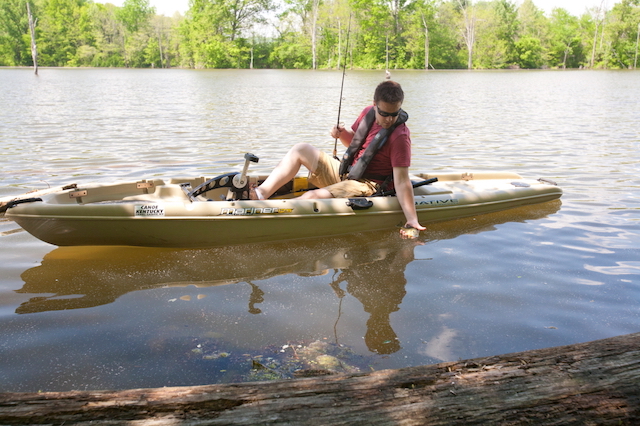| ||||||||||
Dr. Ronald P. Rogers CHIROPRACTOR Support for your body's natural healing capabilities 270-384-5554 Click here for details 


Columbia Gas Dept. GAS LEAK or GAS SMELL Contact Numbers 24 hrs/ 365 days 270-384-2006 or 9-1-1 Call before you dig Visit ColumbiaMagazine's Directory of Churches Addresses, times, phone numbers and more for churches in Adair County Find Great Stuff in ColumbiaMagazine's Classified Ads Antiques, Help Wanted, Autos, Real Estate, Legal Notices, More... 
|
KY Afield Outdoors: Best Kayaks for Flat Water Fishing By Lee McClellan Frankfort, KY - A car, truck or sport utility vehicle with a couple of kayaks on the roof with fishing poles visible through the back window is an increasingly common sight on Kentucky highways. Sales data shows kayak fishing and related kayak accessories increasing in popularity. Some of this popularity has to do with many baby boomers reaching retirement age and wanting a new hobby. Price is another aspect of the rise in popularity of kayak fishing. They are a replacement for a fishing boat for many people scared off by the rising cost of power boats. While many associate kayaks with flowing water, a huge number buy a kayak to fish small lakes, the backwaters of reservoirs, rivers and large farm ponds. "If you want to fish mainly flatwater, the longer, the better for a kayak," said Nathan Depenbrock, co-owner of Canoe Kentucky, an outfitter along the banks of famed Elkhorn Creek near Frankfort. "Length in a kayak gives you speed and tracking. By speed, we don't mean miles per hour. Speed in a kayak is how far you go without paddling. It is also called the glide." Length is relative to kayaks. Two feet of length makes a big difference in how the boat performs. "The ideal length for Kentucky is 12 to 13 feet," explained Dependbrock, who has paddled waters from the Rio Grande River in Texas north to the Great Lakes. "A major consideration is to buy a boat you can get to the water. Make sure it fits in the bed of your truck or on top of your vehicle. A kayak that is too heavy is no good because you won't use it." As kayaks go longer than 14 feet, they also get narrower. "The long kayaks are designed for paddling long distances, not for stability," Depenbrock said. "They can get squirrely at rest." This is why, for fishing, the 12- to 13-foot long kayak makes the best choice. It is long enough for speed, but short enough for width and stability. "I really would not go less than 11 feet long," Depenbrock said. "Being in a boat of 10 or 11 feet is a really frustrating way to paddle on flatwater. They don't perform well at all." He also prefers a sit-on-top or the relatively new hybrid kayaks for flatwater paddling and fishing. "Stay away from the sit in kayaks," Depenbrock explained. "They are not meant to fish out of." Depenbrock also said anglers fishing lakes, rivers or reservoirs out of a kayak must keep in mind their low profile and short length makes a kayak hard to see. "We blend in so much in kayaks, especially on our big lakes," Depenbrock said. "Kayaks can get down in between waves and not be seen. Color is important. Make sure you have a safety flag, a bright paddle or even one of those bright safety vests so other boaters can see you. Always wear something bright." Practice getting back into your kayak from the water before launching. "On bigger lakes, it is really important," Depenbrock said. "You have to be able to get back in the kayak if something happens and are far from the bank." Depenbrock enjoys flatwater kayaking on several spots in Kentucky. "Grayson Lake is one of my best places to paddle," he said. "The scenery is unbelievable. A lot of the rock grottos and other really cool spots are only accessible by kayak." He also loves the Kentucky River. "Every pool in the Kentucky River has its own unique features," Depenbrock said. "Everywhere on the Kentucky River is beautiful, but Pool 6 upstream to Pool 10 is some of the most spectacular scenery in Kentucky. The area in Pool 7 around Camp Nelson is unbelievable. The Kentucky River has a ton of access for paddlers to use as well." In fall, Depenbrock moves down river to Pool 2. "There is good wildlife in Pool 2," he said. "We see bald eagles, coyotes, white-tailed deer, wild turkeys, waterfowl and other kinds of birds." Depenbrock is also exploring the forks of the Kentucky River. "The forks of the Kentucky are really looking good, especially the North Fork of the Kentucky River," he said. "They are really improving. The cleanups are starting to show. I am going to enjoy exploring more of the forks in the coming years." No matter which of these scenic spots Depenbrock is paddling, he always wears his PFD (personal floatation device), commonly called a lifejacket. "No matter what time of year, I never paddle without my PFD," he said. Summer is a time of enjoying water sports. Keep these tips in mind if you plan to get a kayak to fish the many smaller state-owned lakes, reservoirs and rivers in Kentucky. Author Lee McClellan is a nationally award-winning associate editor for Kentucky Afield magazine, the official publication of the Kentucky Department of Fish and Wildlife Resources. He is a life-long hunter and angler, with a passion for smallmouth bass fishing. This story was posted on 2017-06-22 14:12:33
Printable: this page is now automatically formatted for printing.
Have comments or corrections for this story? Use our contact form and let us know.
More articles from topic Ky Afield Outdoors:
Public Meeting held for Hunter Access Program in Barren County KY Afield Outdoors: Grouse restoration plan comes into focus KY Afield Outdoors: Encourage young anglers KY Afield Outdoors: Early Summer Fishing KY Afield Outdoors: Memorial Day kicks off summer boating KY Afield Outdoors: State resort parks for largemouth bass KY Afield Outdoors: Great Late Spring Fishing KY Afield Outdoors: Coyotes in the urban landscape KY Afield Outdoors: Swimbaits fool trophy fish KY Afield Outdoors: Elk quota hunt application deadline View even more articles in topic Ky Afield Outdoors |



|
||||||||
|
| ||||||||||
|
Quick Links to Popular Features
Looking for a story or picture? Try our Photo Archive or our Stories Archive for all the information that's appeared on ColumbiaMagazine.com. | ||||||||||
|
Contact us: Columbia Magazine and columbiamagazine.com are published by Linda Waggener and Pen Waggener, PO Box 906, Columbia, KY 42728. Please use our contact page, or send questions about technical issues with this site to webmaster@columbiamagazine.com. All logos and trademarks used on this site are property of their respective owners. All comments remain the property and responsibility of their posters, all articles and photos remain the property of their creators, and all the rest is copyright 1995-Present by Columbia Magazine. Privacy policy: use of this site requires no sharing of information. Voluntarily shared information may be published and made available to the public on this site and/or stored electronically. Anonymous submissions will be subject to additional verification. Cookies are not required to use our site. However, if you have cookies enabled in your web browser, some of our advertisers may use cookies for interest-based advertising across multiple domains. For more information about third-party advertising, visit the NAI web privacy site.
| ||||||||||




















































